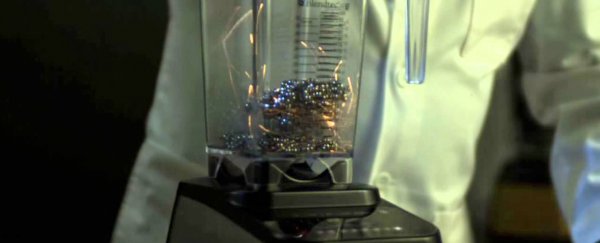Although they've now been banned, neodymium magnet toys, better known as Buckyballs, were once a favourite scientific toy for children and adults alike - their incredible magnetism meant that they could be used to build mind-bending structures.
But the real question is, will they blend?
And from the looks of the video above, it's pretty safe to say the answer is no. Hell no.
Buckyball toys - not to be confused with the C60 molecular cages - are made from neodymium, a rare earth element that, when used within a metal alloy, forms an incredibly powerful magnet.
Over the past two years, the construction and sale of Buckyballs have been banned in the US and Australia by the Consumer Product Safety Commission, because children have the unfortunate tendency of, well, swallowing the little silver balls (seriously, that's worse than it sounds).
So to celebrate the demise of one of his favourite toys, and also welcome the birth of his 40th grandchild - which is impressive enough in itself - Tom Dickson of "Will it Blend?" YouTube Fame decided to give Buckyballs a proper send off.
As part of a viral marketing campaign for blender company Blendtec, Tom has previously blended iPhones, golf balls, cars and even Twilight paraphernalia. But none of them looked quite this spectacular.
Watch above as he dumps a massive clump of Buckyballs into his blender and hits the on button, causing an almost immediate shower of sparks and black smoke.
When the process is filmed in slow motion and the room is darkened, the effect is even more incredible - it looks like some kind of tiny lightning show for mice, captured inside a blender.
By the end of almost a minute of blending time, Tom dumps out the solid black residue left over, along with a cloud of toxic dust.
So what's going on here?
As Malcolm Levitt, the head of Magnetic Resonance for Chemistry at the University of Southampton in the UK, told Victoria Wollaston over at MailOnline: "The sparks are caused by frictional heating, just as for a screeching brake… The metal fragments are strongly magnetic so stick to each other forming a solid mass at the end."
And those orange sparks just continue to get more numerous as a result of neodymium oxiding in the air. As Kevin O'Grady, a physicist at the University of York in the UK told Victoria Wollaston over at MailOnline:
"In fact, neodymium and similar metals are the basis of of flints. Hence if you chip bits off, they ignite in air. As the blending goes on further smaller fragments are produced and the temperature goes up creating more sparks."
So seriously guys, don't try this at home. But feel free to enjoy the light show above.
Sources: Blendtec, MailOnline
